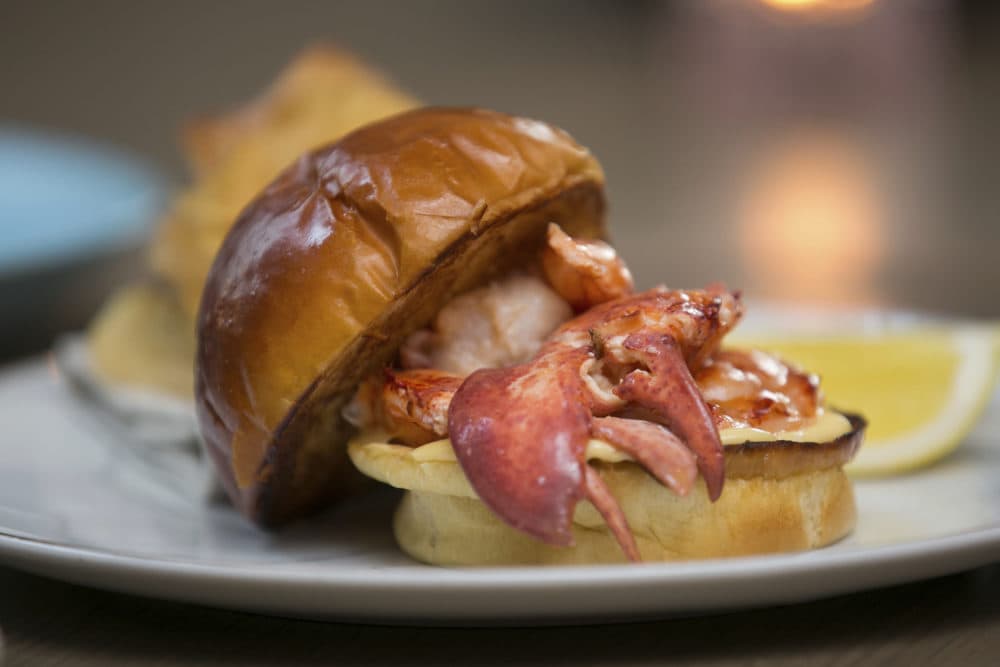Advertisement
$34 For A Lobster Roll? Today's High Prices Driven By Consumer Buying Habits During Pandemic
Resume
Maine seafood prices are experiencing a post-pandemic bump that could persist into the future, a potential bright side to the market dislocations COVID-19 brought to the industry.
A month ago it was headline news when the iconic Wiscasset lobster shack, Red's Eats, opened for the season with no lobster on hand. Today, there is lobster to be had — but hold onto your napkin: a lobster roll there cost $34 this week.
And the story is the same farther off the beaten path.
Gary Blackman Sr. and his wife have been running Karen's Hideaway lobster shack in Boothbay for two decades.
"We go through this every year," Blackman says. "But this year's just been a crazy year."
Lobster rolls there were $28 this week — reflecting dock prices for hard-shell that have been bouncing around $6 to $12 a pound for weeks, and that's when there's product coming in at all.
"I mean the price is way up but the boys aren't catching anything. But that's the kind of year it's been. Why? Nobody has any answers," Blackman says. "It could be the water's too cold, the weather's crazy. I'm hoping that in a week or two, things change."
Lobster landings don't usually get a full head of steam until after Memorial Day, when more boats are in the water and the lobster get more active, shedding their old shells.
But industry experts say the dizzying heights of today's prices are being driven not just by the catch, but by the way consumers changed their buying habits during the pandemic.
"We are seeing really high demand for lobster, for all seafood. And that’s true not only here in Maine but throughout the country," says Annie Tselikis, the executive director of the Maine Lobsters Dealers Association.
She says when lockdowns shuttered much of the restaurant industry last year, seafood sales plummeted.
But as the pandemic wore on, home chefs started to bring out their cookbooks, and experimented.
"Consumers had time to handle seafood at home in a way that they never had before," Tselikis says. "And so people were buying not only lobster but other seafood products from their supermarkets or local fishmongers or directly from fishermen and they were trying things."
Dealers ultimately were able to match that new trend, Tselikis says. Re-packaging and redirecting inventory that had been slated for the food service industry to retail outlets instead. Over time, with some landings lower than usual, an inventory glut abated and is now depleted.
"The amount of frozen product and inventory is low, and the amount of long-term storage for live lobster is also low, by comparison to previous years," Tselikis says. "And our customers are looking for it. There is really strong demand in the marketplace. People are coming out of the pandemic, they are looking to treat themselves."
With restaurants reopening, Tselikis notes that current consumer prices for seafood are up over last year by 19%. That's more than any other food commodity, and may be a sign that at-home cooks and restaurants together are boosting demand to new levels.
And it appears that consumers may be getting more comfortable with seafood items that might be more unfamiliar in the home than, say, a nice frozen lobster tail: live oysters or mussels from Maine, for instance.
"We've seen, nationally, anywhere from a 25% to 35% increase in national sales in Maine aquaculture products," says Sebastian Belle, the executive director of the Maine Aquaculture Association.
He says that a state-sponsored advertising campaign helped to steady sales of Maine seafood through the pandemic's worst ups and downs.
Oyster growers had a particularly tough time of it he says. Oysters are notoriously a hard sell for home consumption — because their shells can seem difficult to open. But Belle says growers have made some inroads, taking to social media to post DIY oyster-shucking videos.
"If you go on Instagram or YouTube or any of those things, you'll see hundreds of videos about how to shuck an oyster," Belle says. "And they've become tremendously popular."
Retail oyster prices are back to pre-pandemic levels. Belle says it's too early to tell whether the pandemic has created a permanent shift in consumer habits. But he is predicting a coming boom in seafood cookbooks.
For everyone in the industry, balancing demand, price, costs and inventory is a constant challenge. Back at Karen's Hideaway in Boothbay, Gary Blackman Sr. says the high prices have hurt his usual May sales levels
But he's not all that worried about the lobster catch this summer.
"I know in a couple weeks, I said they'll be coming out my nose, and I know it," Blackman says. "And then I'll be growling because there's too many."
This story is part of the New England News Collaborative. It was originally published on Maine Public's website.
This segment aired on May 27, 2021.